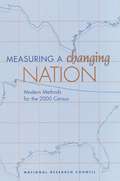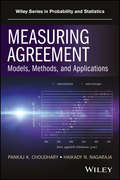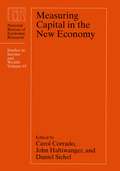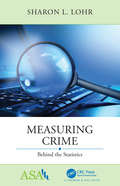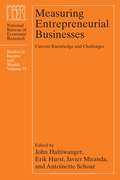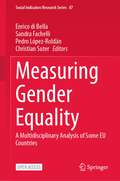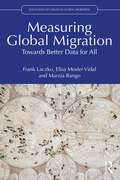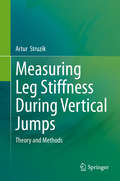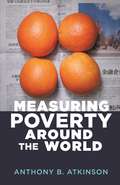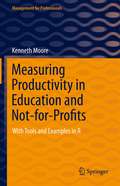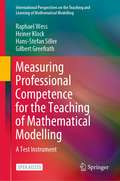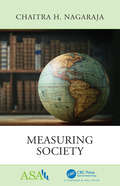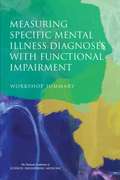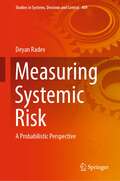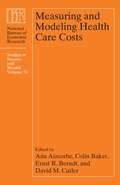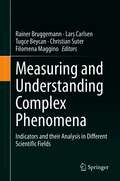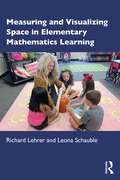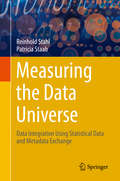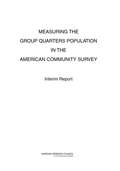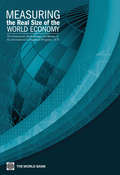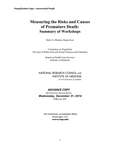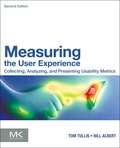- Table View
- List View
Measuring A changing Nation: Modern Methods for the 2000 Census
by Panel on Alternative Census MethodologiesInformation on the Modern Methods for the 2000 Census
Measuring Agreement: Models, Methods, and Applications
by Pankaj K. Choudhary Haikady N. NagarajaPresents statistical methodologies for analyzing common types of data from method comparison experiments and illustrates their applications through detailed case studies Measuring Agreement: Models, Methods, and Applications features statistical evaluation of agreement between two or more methods of measurement of a variable with a primary focus on continuous data. The authors view the analysis of method comparison data as a two-step procedure where an adequate model for the data is found, and then inferential techniques are applied for appropriate functions of parameters of the model. The presentation is accessible to a wide audience and provides the necessary technical details and references. In addition, the authors present chapter-length explorations of data from paired measurements designs, repeated measurements designs, and multiple methods; data with covariates; and heteroscedastic, longitudinal, and categorical data. The book also: * Strikes a balance between theory and applications * Presents parametric as well as nonparametric methodologies * Provides a concise introduction to Cohen's kappa coefficient and other measures of agreement for binary and categorical data * Discusses sample size determination for trials on measuring agreement * Contains real-world case studies and exercises throughout * Provides a supplemental website containing the related datasets and R code Measuring Agreement: Models, Methods, and Applications is a resource for statisticians and biostatisticians engaged in data analysis, consultancy, and methodological research. It is a reference for clinical chemists, ecologists, and biomedical and other scientists who deal with development and validation of measurement methods. This book can also serve as a graduate-level text for students in statistics and biostatistics.
Measuring Capital in the New Economy
by John Haltiwanger Carol Corrado Daniel SichelAs the accelerated technological advances of the past two decades continue to reshape the United States' economy, intangible assets and high-technology investments are taking larger roles. These developments have raised a number of concerns, such as: how do we measure intangible assets? Are we accurately appraising newer, high-technology capital? The answers to these questions have broad implications for the assessment of the economy's growth over the long term, for the pace of technological advancement in the economy, and for estimates of the nation's wealth. In Measuring Capital in the New Economy, Carol Corrado, John Haltiwanger, Daniel Sichel, and a host of distinguished collaborators offer new approaches for measuring capital in an economy that is increasingly dominated by high-technology capital and intangible assets. As the contributors show, high-tech capital and intangible assets affect the economy in ways that are notoriously difficult to appraise. In this detailed and thorough analysis of the problem and its solutions, the contributors study the nature of these relationships and provide guidance as to what factors should be included in calculations of different types of capital for economists, policymakers, and the financial and accounting communities alike.
Measuring Crime: Behind the Statistics (ASA-CRC Series on Statistical Reasoning in Science and Society)
by Sharon L. LohrCrime statistics are everywhere, but how do you know when they’re valid? If a newspaper report says "the rate of overall violent crime decreased by 0.9 percent," how can you tell where that statistic came from, what it measures, and how accurate it is? Is it worth repeating or sharing? Measuring Crime: Behind the Statistics gives you the tools to interpret and evaluate crime statistics’ quality and usefulness. The book focuses on ways of thinking about crime statistics (no formulas!) and features Eight questions you should ask before quoting a statistic The two sources of information about homicide FBI statistics: what do they measure? How victimization surveys can reflect your experiences even though you were not asked to participate Special considerations when interpreting statistics about sexual assault and fraud Examples of experiments and studies on how to improve crime statistics Two online supplements containing additional details and links to data sources Whether you are a law enforcement professional, journalist, student, or interested citizen, Measuring Crime: Behind the Statistics will tell you how to read statistics as a statistician would. Sharon Lohr, the author of Sampling: Design and Analysis, has published widely about statistical methods for education, public policy, law, and crime. She has been recognized as Fellow of the American Statistical Association, elected member of the International Statistical Institute, and recipient of the Gertrude M. Cox Statistics Award and the Deming Lecturer Award. Formerly Dean’s Distinguished Professor of Statistics at Arizona State University and a Vice President at Westat, she is now a freelance statistical consultant and writer. Visit her website at www.sharonlohr.com. "The book aims to achieve two goals: introduce statistical ideas to a general audience and provide an overview of US crime statistics. These are disparate topics, but in the way they are approached here, there is a strong synergy that reinforces both aspects. One the one hand, the reader's natural curiosity about crime (what is it, how are crime events classified and reported, how reliable are the numbers you see in the newspaper, etc.) will help him/her become interested in the statistical issues and learn these concepts in a practical and concrete setting. And on the other hand, by reading about the statistical issues surrounding crime data, he/she gains a better appreciation for the complexities of crime statistics, eventually acquiring a deeper understanding of them. As a statistician myself, I learned interesting facts about the types of crime, their nomenclature and the possible confusion surrounding them, and how the data are collected and reported. Overall, I think the combination is effective and very well developed in this book." (Jean Opsomer, Westat) "This book is an excellent primer on handling the mass of data and information researchers are faced with. While it is geared toward followers of criminal justice information, much of the book is a very good introduction to survey techniques discussing their strong and weak points. Most importantly, there are very good guidelines and questions that one should employ before citing any data or using data for policy decisions or for reporting on data such as journalists do. The book is written in a non-technical manner and does a very good job of explaining the nuances in reviewing data. Any researcher who utilizes data would find this valuable. While it has specific examples in the criminal justice field, it really is quite useful for any user of data." (Barry Nussbaum, former President American Statistical Association)
Measuring Economic Sustainability and Progress
by Dale W. Jorgenson J. Steven Landefeld Paul SchreyerSince the Great Depression, researchers and statisticians have recognized the need for more extensive methods for measuring economic growth and sustainability. The recent recession renewed commitments to closing long-standing gaps in economic measurement, including those related to sustainability and well-being. The latest in the NBER's influential Studies in Income and Wealth series, which has played a key role in the development of national account statistics in the United States and other nations, this volume explores collaborative solutions between academics, policy researchers, and official statisticians to some of today's most important economic measurement challenges. Contributors to this volume extend past research on the integration and extension of national accounts to establish an even more comprehensive understanding of the distribution of economic growth and its impact on well-being, including health, human capital, and the environment. The research contributions assess, among other topics, specific conceptual and empirical proposals for extending national accounts.
Measuring Entrepreneurial Businesses: Current Knowledge and Challenges
by Antoinette Schoar John Haltiwanger Erik Hurst Javier MirandaStart-ups and other entrepreneurial ventures make a significant contribution to the US economy, particularly in the tech sector, where they comprise some of the largest and most influential companies. Yet for every high-profile, high-growth company like Apple, Facebook, Microsoft, and Google, many more fail. This enormous heterogeneity poses conceptual and measurement challenges for economists concerned with understanding their precise impact on economic growth. Measuring Entrepreneurial Businesses brings together economists and data analysts to discuss the most recent research covering three broad themes. The first chapters isolate high- and low-performing entrepreneurial ventures and analyze their roles in creating jobs and driving innovation and productivity. The next chapters turn the focus on specific challenges entrepreneurs face and how they have varied over time, including over business cycles. The final chapters explore core measurement issues, with a focus on new data projects under development that may improve our understanding of this dynamic part of the economy.
Measuring Gender Equality: A Multidisciplinary Analysis of Some EU Countries (Social Indicators Research Series #87)
by Christian Suter Pedro López-Roldán Sandra Fachelli Enrico Di BellaIn this open access book, the editors explicitly address the issue of measuring gender equality. The book introduces readers to basic concepts of gender equality, equity and equal opportunities, then discusses measuring these phenomena, the methods of constructing indicators, and reviews the main indicators that have been proposed at the international level to measure gender equality. It then sets the theoretical discussions against the findings from a Jean Monnet project financed by the European Union to highlight the importance of a regional analysis of gender equality in four main study areas: Italy, Spain, France and Germany. The results make it clear that it is necessary to move from the purely national perspective hitherto used in gender equality analyses to a regional one because differences can be highly pronounced even within the same country. This is a self-contained volume requiring limited statistical expertise for the reader and is aimed at social researchers and policymakers who wish to address gender equality from a quantitative perspective.
Measuring Global Migration: Towards Better Data for All (Routledge Key Issues in Global Migration)
by Frank Laczko Elisa Mosler Vidal Marzia RangoThis book focuses on how to improve the collection, analysis and responsible use of data on global migration and international mobility.While migration remains a topic of great policy interest for governments around the world, there is a serious lack of reliable, timely, disaggregated and comparable data on it, and often insufficient safeguards to protect migrants’ information. Meanwhile, vast amounts of data about the movement of people are being generated in real time due to new technologies, but these have not yet been fully captured and utilized by migration policymakers, who often do not have enough data to inform their policies and programmes. The lack of migration data has been internationally recognized; the Global Compact for Safe, Orderly and Regular Migration urges all countries to improve data on migration to ensure that policies and programmes are "evidence-based", but does not spell out how this could be done. This book examines both the technical data issues associated with improving data on migration and the wider political challenges of how countries manage the collection and use of migration data. The first part of the book discusses how much we really know about international migration based on existing data, and key concepts and approaches which are often used to measure migration. The second part of the book examines what measures could be taken to improve migration data, highlighting examples of good practice from around the world in recent years, across a range of different policy areas, such as health, climate change and sustainable development more broadly. Written by leading experts on international migration data, this book is the perfect guide for students, policymakers and practitioners looking to understand more about the existing evidence base on migration and what can be done to improve it.
Measuring Leg Stiffness During Vertical Jumps: Theory and Methods
by Artur StruzikThis book presents a thorough description and critical discussion of different approaches to measuring leg stiffness during vertical jumps, as well as practical applications. Various topics covered include the applicability of the spring-mass (linear) model of the human motion system, leg stiffness controversies and interpretations, and computational and measuring methods of leg stiffness during vertical jumps. Additionally, a description of a research project performed expressly for inclusion in this book is given; the study aims to determine normative values for leg stiffness for young, healthy, non-athletes during single vertical jumps to maximal and specific heights. A final chapter covers additional perspectives, enabling the reader to acquire different perspectives on measuring leg stiffness during vertical jumps across a breadth of information and interpretations.Measuring Leg Stiffness During Vertical Jumps: Theory and Methods is an ideal book for researchers and practitioners in the fields of biomedical engineering, biomechanics, and sport sciences.
Measuring Poverty around the World
by Anthony B. AtkinsonThe final book from a towering pioneer in the study of poverty and inequality—a critically important examination of poverty around the worldIn this, his final book, economist Anthony Atkinson, one of the world’s great social scientists and a pioneer in the study of poverty and inequality, offers an inspiring analysis of a central question: What is poverty and how much of it is there around the globe? The persistence of poverty—in rich and poor countries alike—is one of the most serious problems facing humanity. Better measurement of poverty is essential for raising awareness, motivating action, designing good policy, gauging progress, and holding political leaders accountable for meeting targets. To help make this possible, Atkinson provides a critically important examination of how poverty is—and should be—measured.Bringing together evidence about the nature and extent of poverty across the world and including case studies of sixty countries, Atkinson addresses both financial poverty and other indicators of deprivation. He starts from first principles about the meaning of poverty, translates these into concrete measures, and analyzes the data to which the measures can be applied. Crucially, he integrates international organizations’ measurements of poverty with countries’ own national analyses.Atkinson died before he was able to complete the book, but at his request it was edited for publication by two of his colleagues, John Micklewright and Andrea Brandolini. In addition, François Bourguignon and Nicholas Stern provide afterwords that address key issues from the unfinished chapters: how poverty relates to growth, inequality, and climate change.The result is an essential contribution to efforts to alleviate poverty around the world.
Measuring Productivity in Education and Not-for-Profits: With Tools and Examples in R (Management for Professionals)
by Kenneth MooreThis book takes the reader through real-world examples for how to characterize and measure the productivity and performance of NFPs and education institutions—that is, organisations that produce value for society, which cannot be measured accurately in financial KPIs. It focuses on how best to frame non-profit performance and productivity, and provides a suite of tools for measurement and benchmarking. It further challenges the reader to consider alternative and appropriate uses of quantitative measures, which are fit-for-purpose in individual contexts.It is true that the risk of misusing quantitative measures is ever-present. But does that risk outweigh the benefits of forming a more precise and shared understanding of what could generate better outcomes? There will always be concerns about policy and performance management. Goodheart’s Law states that once a measure becomes a target, it is no longer a good measure. This book helps to strike a meaningful balance between what can be measured, what cannot, and how best to use quantitative information in sectors that are often averse to being held up to the light and put on a scale by outsiders.
Measuring Professional Competence for the Teaching of Mathematical Modelling: A Test Instrument (International Perspectives on the Teaching and Learning of Mathematical Modelling)
by Gilbert Greefrath Hans-Stefan Siller Raphael Wess Heiner KlockThis open access book presents a structural model and an associated test instrument designed to provide a detailed analysis of professional competences for teaching mathematical modelling. The conceptualisation is based on the COACTIV model, which describes aspects, areas and facets of professional competences of teachers. The manual provides an overview of the essential teaching skills in application-related contexts and offers the tools needed to capture these aspects. It discusses the objectives and application areas of the instrument, as well as the development of the test. In addition, it describes the implementation and evaluates the quality and results of the structural equation analysis of the model. Teaching mathematical modelling is a cognitively challenging activity for (prospective) teachers. Thus, teacher education requires a detailed analysis of professional competence for teaching mathematical modelling. Measuring this competence requires theoretical models that accurately describe requirements placed upon teachers, as well as appropriate evaluation tools that adequately capture skills and abilities in this field. This book presents an instrument that measures the professional competences in a sample of 349 prospective teachers.
Measuring Society (ASA-CRC Series on Statistical Reasoning in Science and Society)
by Chaitra H. NagarajaCollecting and analyzing data on unemployment, inflation, and inequality help describe the complex world around us. When published by the government, such data are called official statistics. They are reported by the media, used by politicians to lend weight to their arguments, and by economic commentators to opine about the state of society. Despite such widescale use, explanations about how these measures are constructed are seldom provided for a non-technical reader. This Measuring Society book is a short, accessible guide to six topics: jobs, house prices, inequality, prices for goods and services, poverty, and deprivation. Each relates to concepts we use on a personal level to form an understanding of the society in which we live: We need a job, a place to live, and food to eat. Using data from the United States, we answer three basic questions: why, how, and for whom these statistics have been constructed. We add some context and flavor by discussing the historical background. This book provides the reader with a good grasp of these measures. Chaitra H. Nagaraja is an Associate Professor of Statistics at the Gabelli School of Business at Fordham University in New York. Her research interests include house price indices and inequality measurement. Prior to Fordham, Dr. Nagaraja was a researcher at the U.S. Census Bureau. While there, she worked on projects relating to the American Community Survey.
Measuring Specific Mental Illness Diagnoses with Functional Impairment: Workshop Summary
by Engineering Medicine National Academies of SciencesThe workshop summarized in this report was organized as part of a study sponsored by the Substance Abuse and Mental Health Services Administration (SAMHSA) and the Office of the Assistant Secretary for Planning and Evaluation of the U.S. Department of Health and Human Services, with the goal of assisting SAMHSA in its responsibilities of expanding the collection of behavioral health data in several areas. The workshop brought together experts in mental health, psychiatric epidemiology and survey methods to facilitate discussion of the most suitable measures and mechanisms for producing estimates of specific mental illness diagnoses with functional impairment. The report discusses existing measures and data on mental disorders and functional impairment, challenges associated with collecting these data in large-scale population-based studies, as well as study design and estimation options.
Measuring Systemic Risk: A Probabilistic Perspective (Studies in Systems, Decision and Control #409)
by Deyan RadevThis book provides a comprehensive methodology to measure systemic risk in many of its facets and dimensions based on state-of-the-art risk assessment methods. Systemic risk has gained attention in the public eye since the collapse of Lehman Brothers in 2008. The bankruptcy of the fourth-biggest bank in the USA raised questions whether banks that are allowed to become “too big to fail” and “too systemic to fail” should carry higher capital surcharges on their size and systemic importance. The Global Financial Crisis of 2008-2009 was followed by the Sovereign Debt Crisis in the euro area that saw the first Eurozone government de facto defaulting on its debt and prompted actions at international level to stem further domino and cascade effects to other Eurozone governments and banks. Against this backdrop, a careful measurement of systemic risk is of utmost importance for the new capital regulation to be successful and for sovereign risk to remain in check. Most importantly, the book introduces a number of systemic fragility indicators for banks and sovereigns that can help to assess systemic risk and the impact of macroprudential and microprudential policies.
Measuring Uncertainty within the Theory of Evidence: Within The Theory Of Evidence (Springer Series in Measurement Science and Technology)
by Simona Salicone Marco PrioliThis monograph considers the evaluation and expression of measurement uncertainty within the mathematical framework of the Theory of Evidence. With a new perspective on the metrology science, the text paves the way for innovative applications in a wide range of areas. Building on Simona Salicone’s Measurement Uncertainty: An Approach via the Mathematical Theory of Evidence, the material covers further developments of the Random Fuzzy Variable (RFV) approach to uncertainty and provides a more robust mathematical and metrological background to the combination of measurement results that leads to a more effective RFV combination method.While the first part of the book introduces measurement uncertainty, the Theory of Evidence, and fuzzy sets, the following parts bring together these concepts and derive an effective methodology for the evaluation and expression of measurement uncertainty. A supplementary downloadable program allows the readers to interact with the proposed approach by generating and combining RFVs through custom measurement functions. With numerous examples of applications, this book provides a comprehensive treatment of the RFV approach to uncertainty that is suitable for any graduate student or researcher with interests in the measurement field.
Measuring and Modeling Health Care Costs (National Bureau of Economic Research Studies in Income and Wealth #76)
by Colin Baker David M. Cutler Ana Aizcorbe Ernst R. BerndtHealth care costs represent a nearly 18% of U.S. gross domestic product and 20% of government spending. While there is detailed information on where these health care dollars are spent, there is much less evidence on how this spending affects health. The research in Measuring and Modeling Health Care Costs seeks to connect our knowledge of expenditures with what we are able to measure of results, probing questions of methodology, changes in the pharmaceutical industry, and the shifting landscape of physician practice. The research in this volume investigates, for example, obesity’s effect on health care spending, the effect of generic pharmaceutical releases on the market, and the disparity between disease-based and population-based spending measures. This vast and varied volume applies a range of economic tools to the analysis of health care and health outcomes. Practical and descriptive, this new volume in the Studies in Income and Wealth series is full of insights relevant to health policy students and specialists alike.
Measuring and Reasoning
by Fred L. BooksteinIn Measuring and Reasoning, Fred L. Bookstein examines the way ordinary arithmetic and numerical patterns are translated into scientific understanding, showing how the process relies on two carefully managed forms of argument: • Abduction: the generation of new hypotheses to accord with findings that were surprising on previous hypotheses, and • Consilience: the confirmation of numerical pattern claims by analogous findings at other levels of measurement. These profound principles include an understanding of the role of arithmetic and, more importantly, of how numerical patterns found in one study can relate to numbers found in others. They are illustrated through numerous classic and contemporary examples arising in disciplines ranging from atomic physics through geosciences to social psychology. The author goes on to teach core techniques of pattern analysis, including regression and correlation, normal distributions, and inference, and shows how these accord with abduction and consilience, first in the simple setting of one dependent variable and then in studies of image data for complex or interdependent systems. More than 200 figures and diagrams illuminate the text. The book can be read with profit by any student of the empirical nature or social sciences and by anyone concerned with how scientists persuade those of us who are not scientists why we should credit the most important claims about scientific facts or theories.
Measuring and Understanding Complex Phenomena: Indicators and their Analysis in Different Scientific Fields
by Christian Suter Filomena Maggino Lars Carlsen Rainer Bruggemann Tugce BeycanIndicators are more and more applied to describe and analyze complex systems. Typical examples: Innovation potential of nations, child-well being, Environmental health, poverty, chemical pollution, corruption of nations. The task is: How can a system of indicators be defined in order to fulfill the above expectations. One possibility is the application of the mathematical theory of partial order, especially when the indicator system shall be used for ranking purposes.
Measuring and Visualizing Space in Elementary Mathematics Learning
by Richard Lehrer Leona SchaubleMeasuring and Visualizing Space in Elementary Mathematics Learning explores the development of elementary students’ understanding of the mathematics of measure, and demonstrates how measurement can serve as an anchor for supporting a deeper understanding of number operations and rational numbers. The concept of measurement is centrally implicated in a number of mathematical operations, yet is not often given the placement it deserves in the elementary mathematics curriculum. By drawing on K-5 classroom research, authors Lehrer and Schauble have been able to articulate a learning progression that describes benchmarks of student learning about measure in length, angle, area, volume, and rational number, exploring related concepts, classroom experiences, and instructional practices at each stage. Offering a unique, research driven resource for helping students develop a deep understanding of measurement to further enhance mathematical understanding, as well as further learning in other STEM disciplines; the book will be relevant for scholars, teacher educators, and specialists in math education. The book is accompanied by online resources developed for practitioners, including instructional guides, examples of student thinking, and other teacher-focused materials, helping clarify how to bring concepts of measure and rational number to life in classrooms.
Measuring the Data Universe: Data Integration Using The Statistical Data And Metadata Exchange
by Reinhold Stahl Patricia StaabThis richly illustrated book provides an easy-to-read introduction to the challenges of organizing and integrating modern data worlds, explaining the contribution of public statistics and the ISO standard SDMX (Statistical Data and Metadata Exchange). As such, it is a must for data experts as well those aspiring to become one.Today, exponentially growing data worlds are increasingly determining our professional and private lives. The rapid increase in the amount of globally available data, fueled by search engines and social networks but also by new technical possibilities such as Big Data, offers great opportunities. But whatever the undertaking – driving the block chain revolution or making smart phones even smarter – success will be determined by how well it is possible to integrate, i.e. to collect, link and evaluate, the required data. One crucial factor in this is the introduction of a cross-domain order system in combination with a standardization of the data structure. Using everyday examples, the authors show how the concepts of statistics provide the basis for the universal and standardized presentation of any kind of information. They also introduce the international statistics standard SDMX, describing the profound changes it has made possible and the related order system for the international statistics community.
Measuring the Group Quarters Population in the American Community Survey: Interim Report
by National Research Council of the National AcademiesFollowing several years of testing and evaluation, the American Community Survey (ACS) was launched in 2005 as a replacement for the census "long form," used to collect detailed social, economic, and housing data from a sample of the U.S. population as part of the decennial census. During the first year of the ACS implementation, the Census Bureau collected data only from households. In 2006 a sample of group quarters (GQs) -- such as correctional facilities, nursing homes, and college dorms -- was added to more closely mirror the design of the census long-form sample. The design of the ACS relies on monthly samples that are cumulated to produce multiyear estimates based on 1, 3, and 5 years of data. The data published by the Census Bureau for a geographic area depend on the area's size. The multiyear averaging approach enables the Census Bureau to produce estimates that are intended to be robust enough to release for small areas, such as the smallest governmental units and census block groups. However, the sparseness of the GQ representation in the monthly samples affects the quality of the estimates in many small areas that have large GQ populations relative to the total population. The Census Bureau asked the National Research Council to review and evaluate the statistical methods used for measuring the GQ population. This book presents recommendations addressing improvements in the sample design, sample allocation, weighting, and estimation procedures to assist the Census Bureau's work in the very near term, while further research is conducted to address the underlying question of the relative importance and costs of the GQ data collection in the context of the overall ACS design.
Measuring the Real Size of the World Economy: The Framework, Methodology, and Results of the International Comparison Program (ICP)
by the editors at The World BankMeasuring the Real Size of the World Economy: The Framework, Methodology, and Results of the International Comparison Program—ICP is the most comprehensive accounting ever presented by the International Comparison Program (ICP) of the theory and methods underlying the estimation of purchasing power parities (PPPs). PPPs reveal the relative sizes of economies by converting their gross domestic products and related measurements into a common currency, thereby enabling comparisons based on economic and statistical theory. By disclosing the theory, concepts, and methods underlying the estimates, this book increases the transparency of the ICP process. Greater transparency allows researchers, users of PPPs, and those involved in implementation of the program to better understand the strengths, limitations, and assumptions underlying its results. is book also provides a forward-looking view of methodological developments with an eye toward improving the quality of future comparisons. The ICP is now the largest and most complex statistical program in the world. In 2005 it included 100 countries and economies, working in parallel with the 46 countries in the Eurostat-Organisation for Economic Co-operation and Development (OECD) PPP program. Measuring the Real Size of the World Economy was prepared by the ICP Global Office in the World Bank, with contributions from the leading international experts in the fields of economics and statistics on international comparisons.
Measuring the Risks and Causes of Premature Death: Summary of Workshops
by Holly G. Rhodes"Measuring the Risks and Causes of Premature Death" is the summary of two workshops conducted by The Committee on Population of the National Research Council at the National Academies to address the data sources, science and future research needs to understand the causes of premature mortality in the United States. The workshops reviewed previous work in the field in light of new data generated as part of the work of the NRC Panel on Understanding Divergent Trends in Longevity in High-Income Countries (NRC, 2011) and the NRC/IOM Panel on Understanding Cross-National Differences Among High-Income Countries (NRC/IOM, 2013). The workshop presentations considered the state of the science of measuring the determinants of the causes of premature death, assessed the availability and quality of data sources, and charted future courses of action to improve the understanding of the causes of premature death. Presenters shared their approaches to and results of measuring premature mortality and specific risk factors, with a particular focus on those factors most amenable to improvement through public health policy. This report summarizes the presentations and discussion of both workshops.
Measuring the User Experience: Collecting, Analyzing, and Presenting Usability Metrics (Second Edition)
by William Albert Thomas TullisMeasuring the User Experience was the first book that focused on how to quantify the user experience. Now in the second edition, the authors include new material on how recent technologies have made it easier and more effective to collect a broader range of data about the user experience. As more UX and web professionals need to justify their design decisions with solid, reliable data, Measuring the User Experience provides the quantitative analysis training that these professionals need. The second edition presents new metrics such as emotional engagement, personas, keystroke analysis, and net promoter score. It also examines how new technologies coming from neuro-marketing and online market research can refine user experience measurement, helping usability and user experience practitioners make business cases to stakeholders. The book also contains new research and updated examples, including tips on writing online survey questions, six new case studies, and examples using the most recent version of Excel. Learn which metrics to select for every case, including behavioral, physiological, emotional, aesthetic, gestural, verbal, and physical, as well as more specialized metrics such as eye-tracking and clickstream data. Find a vendor-neutral examination of how to measure the user experience with web sites, digital products, and virtually any other type of product or system. Discover in-depth global case studies showing how organizations have successfully used metrics and the information they revealed. Companion site, www. measuringux. com, includes articles, tools, spreadsheets, presentations, and other resources to help you effectively measure the user experience
